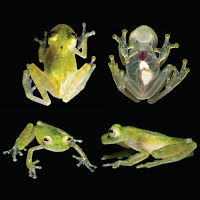 |
| Hyalinobatrachium yaku
Guayasamin, Cisneros-Heredia, Maynard, Lynch, Culebras & Hamilton, 2017
DOI: 10.3897/zookeys.673.12108 |
Abstract
Hyalinobatrachium is a behaviorally and morphologically conserved genus of Neotropical anurans, with several pending taxonomic problems. Using morphology, vocalizations, and DNA, a new species from the Amazonian lowlands of Ecuador is described and illustrated. The new species, Hyalinobatrachium yaku sp. n., is differentiated from all other congenerics by having small, middorsal, dark green spots on the head and dorsum, a transparent pericardium, and a tonal call that lasts 0.27–0.4 s, with a dominant frequency of 5219.3–5329.6 Hz. Also, a mitochondrial phylogeny for the genus is presented that contains the new species, which is inferred as sister to H. pellucidum. Conservation threats to H. yaku sp. n. include habitat destruction and/or pollution mainly because of oil and mining activities.
Keywords: Amazonia, Amphibia, Centrolenidae, Hyalinobatrachium, Ecuador, new species
Systematics
Hyalinobatrachium yaku sp. n.
Suggested English name: Yaku Glassfrog
Suggested Spanish name: Rana de Cristal Yaku
 |
| Figure 1. Hyalinobatrachium yaku sp. n. in life. Top row: adult male, MZUTI 5001, holotype, in dorsal and ventral view. Bottom row: adult male, paratype, QCAZ 55628. |
Etymology: The specific epithet yaku is the Kichwa word for water. Water, in the form of streams, is fundamental for the reproductive biology of all glassfrogs. Water pollution, mainly through oil and mining activities, represents one of the biggest threats for Amazonian amphibians, as well as for numerous other water-dependent species.
Evolutionary relationships: All inferred phylogenetic trees show that Hyalinobatrachium yaku and H. pellucidum are sister species (Fig. 2). Trees obtained for each mitochondrial gene trees are congruent with the tree shown in Figure 2.
Distribution: Hyalinobatrachium yaku is only known from three localities on the Amazonian lowlands of Ecuador at elevations between 300–360 m. The two most-distant sites, Kallana in province of Pastaza, and San José de Payamino in province of Orellana, are approximately 110 km from one another, while Ahuano, province of Napo, is midway between them (Fig. 6). Given the geographic distance between the localities where the new species has been found, it is likely that H. yaku has a broader distribution, including areas in nearby Peru.
 |
| Figure 4. Juvenile of Hyalinobatrachium yaku in life, QCAZ 53354. |
Juan M. Guayasamin, Diego F. Cisneros-Heredia, Ross J. Maynard, Ryan L. Lynch, Jaime Culebras and Paul S. Hamilton. 2017. A Marvelous New Glassfrog (Centrolenidae, Hyalinobatrachium) from Amazonian Ecuador.
ZooKeys. 673: 1-20. DOI: 10.3897/zookeys.673.12108
ZooKeys. 673: 1-20. DOI: 10.3897/zookeys.673.12108
Resumen: Hyalinobatrachium es un género de ranas Neotropicales con una morfología y comportamiento sumamente conservados, y con varios problemas taxonómicos no resueltos. Utilizando datos morfológicos, cantos y ADN, en el presente trabajo describimos una nueva especie de las tierras bajas de la Amazonía del Ecuador. La nueva especie, Hyalinobatrachium yaku sp. n., se diferencia de todos sus congenéricos por tener una serie de puntos mediodorsales color verde oscuros en la cabeza y cuerpo, pericardio transparente, y un canto tonal con una duración de 0.27–0.4 s, con una frecuencia dominante 5219.3–5329.6 Hz. También presentamos una filogenia mitocondrial del género, la cual incluye la nueva especie y a su especie hermana, H. pellucidum. Las amenazas de conservación para H. yaku sp. n. incluyen principalmente la destrucción y/o contaminación del hábitat debido a actividades mineras y petroleras.
Palabras claves: Amazonia, Amphibia, Centrolenidae, Hyalinobatrachium, Ecuador, nueva especie
